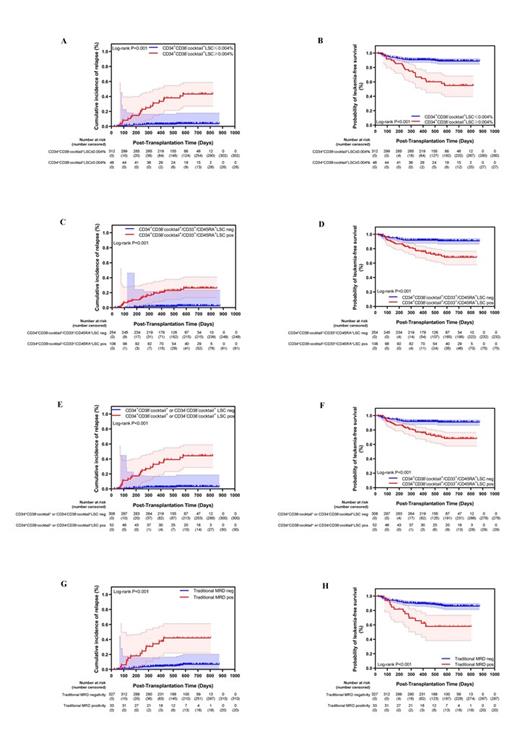Abstract
Background: Minimal/measurable residual disease (MRD) determined by multiparameter flow cytometry (MFC) is an important variable for relapse prediction and treatment approach selection in patients with acute myeloid leukemia (AML). We aimed to investigate whether leukemia-stem cell (LSC)-based assay is superior to traditional MFC methods, including LAIP and D-F-N assays, for MRD evaluation in predicting clinical outcomes.
Methods: In this cohort study, a total of 360 AML patients who received allogeneic stem cell transplantation (allo-SCT) between July 2018 and November 2019 were prospectively enrolled. The patients were randomized (1:1) and classified into a training set (n=180) and a validation set (n=180). Posttransplantation MRD were according to LSC based assay, mainly including a cocktail of CD7, CD11b, CD22, CD56, Tim-3, and CLL-1 on CD34 +CD38 - cells, and traditional assay determined by MFC, respectively.
Findings: In the training set, patients were classified as LSC positive group (group A) and LSC negative group (group B) according to a cutoff value of CD34 +CD38 -cocktail + LSCs as 0.004%. Subjects in group A had a higher cumulative incidence of relapse (CIR, 42.7% vs. 2.6%, P<0.001) and comparable non-relapse mortality (NRM, 0% vs. 8.1%, P=0.154) compared with cases in group B, leading to inferior leukemia-free survival (LFS, 57.3% vs. 89.3%, P<0.001) and overall survival (OS, 70.8% vs. 90%, P=0.009) of cases in group A to group B. Multivariate analysis showed that positive LSCs after transplantation could independently predict CIR (P<0.001), LFS (P<0.001), and OS (P=0.021). The predictive value of positive LSCs following allo-HSCT for CIR (P<0.001), LFS (P<0.001), and OS (P=0.004) was further confirmed in the validation set. In the total case cohort, multivariate analysis also showed that positive LSCs after transplantation could independently predict CIR (HR=13.999, P<0.001), LFS (HR=5.429, P<0.001), and OS (HR=3.761, P=0.021). The total patients were classified into positive MRD and negative MRD groups according to the traditional MFC method. The results showed that the CIR of patients in the traditional MRD positive group was significantly higher than the CIR of patients in the traditional MRD negative group (44.9% vs. 7.3%, P<0.001), leading to lower LFS (55.1% vs. 85.6%, P<0.001) and OS (55.6% vs. 87.5%, P<0.001). Compared with MRD detected by the traditional MFC method, using LSCs for MRD evaluation has high sensitivity (66.7% vs. 43%), a high C-index (0.76 vs. 0.69) and a high Youden index (0.58 vs. 0.37). The median time from CD34 +CD38cocktail + LSC positivity to relapse was longer than the median time from traditional MRD positivity to relapse by 141.5 days (range, 18-465 days) vs. 64.5 days (range, 13-144 days) (P=0.003). The median level between CD34 +CD38 -cocktail + LSCs and traditional MRD detected by MFC was 0.0072% (range, 0.0007%-3.742%) and 0.16% (range, 0.01%-3.75%) (P<0.001).
Interpretation: Our data suggest the superiority of LSC-based MRD assays such as higher sensitivity, low false negativity, and longer time for MRD positivity to relapse to traditional MFC MRD methods for outcome prediction in AML patients received allograft.
No relevant conflicts of interest to declare.


This feature is available to Subscribers Only
Sign In or Create an Account Close Modal